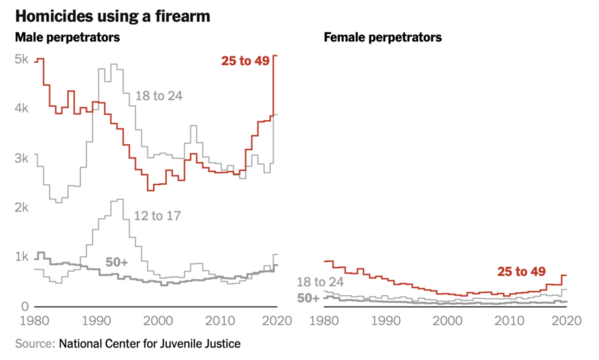In light of the three recent mass shootings in the last three days in California—Monterey Park, Half Moon Bay and Oakland—take a look at "A Smarter Way to Reduce Gun Deaths" that Nicholas Kristof posted in the New York Times.
To solve this plague of violence requires many parts working together, he says.
Using alarming and revealing data and graphs, he includes these among his many recommendations:
- Keep guns out of the hands of people under 21 (Wyoming has such a law), as well as those convicted of violent misdemeanors, such as family violence.
- Ban machine guns.
- Require a gun license for any gun, in the same way we a process to drive a car (Massachusetts and North Carolina do this).
Tax the guns most used in homicides—handguns (like cigarettes)
And then there are the approaches to reduce gun violence that have nothing to do with guns, he says:
- Curb lead exposure in infants.
- Counseling.
- Violence interrupter programs, such as Cure Violence, to reduce revenge shootings.
 Gun violence is clearly a public health issue, he says. But he didn't mention a critically important element to prevent gun violence: reducing adversity in childhood while increasing positive childhood experiences. That's one of the many important ways to prevent gun violence, and not just gun violence, but any violence as well as being a victim of violence.
Gun violence is clearly a public health issue, he says. But he didn't mention a critically important element to prevent gun violence: reducing adversity in childhood while increasing positive childhood experiences. That's one of the many important ways to prevent gun violence, and not just gun violence, but any violence as well as being a victim of violence.
In a 2019 Los Angeles Times article, “We have studied every mass shooting since 1966. Here’s what we’ve learned about the shooters”, Jillian Peterson and James Delaney wrote: “First, the vast majority of mass shooters in our study experienced early childhood trauma and exposure to violence at a young age. The nature of their exposure included parental suicide, physical or sexual abuse, neglect, domestic violence, and/or severe bullying.”
Research clearly shows that the road that leads from a precious infant becoming an abused or neglected child who grows up to become a distressed murderer is predictable. That was revealed in the CDC-Kaiser Permanente Adverse Childhood Experiences Study.
The ACE Study showed a remarkable link between 10 types of childhood trauma and being violent or a victim of violence, as well as experiencing the adult onset of chronic disease and mental illness. The ten types of childhood trauma include experiencing physical and emotional abuse, neglect, living with a family member who is addicted to alcohol or who is mentally ill, and witnessing domestic violence. (For more information, see PACEs Science 101 and What ACEs/PCEs Do You Have?) Subsequent ACE surveys include experiencing bullying, racism, the foster care system, living in a dangerous community, losing a family member to deportation and being a war refugee, among other traumatic experiences.
The point is—and the science is irrefutable now—just as a bullet rips through flesh and bone, a child experiencing ongoing encounters that cause toxic stress, without positive intervention to help the child, will suffer damage to the structure and function of their brain.
Although we can’t predict if a kid with ACEs will express their toxic stress outwardly in violence to others, or turn inward to harm to themselves, or, in some cases, do both, we know enough to say that damage will occur to themselves or others. So, we need to intervene at every step of the way to prevent harm. Warning signs will always show themselves, if we’re educated to see them, no matter a person's age. And if we address these signs, if our systems integrate practices based on PACEs science, we have a better shot at preventing not just violence, such as mass shootings, but all other ways childhood adversity can affect us as adults
As Kristof noted: Public health mostly is not about one big thing but about a million small things.
What we hear now from officials about the three people who did the shootings is: "We're looking for a motive." If we want to prevent shootings, asking about motive will just get you a useless answer to the wrong question. Motives don’t explain the roots of why mass shooters start their journey as innocent babies and end up on a road to killing people. And in those roots, are our solutions.
If you use the lens of the science of positive and adverse childhood experiences, the answer reveals itself, and pretty quickly. Grappling with gun violence by focusing on one solution has clearly failed, as Kristof points out, as does focusing on guns alone.
As a long-term strategy, playing Whac-A-Mole doesn't work to significantly reduce any of our most intractable problems. The challenge is to implement a coordinated, community-wide cross-sector approach, as PACEs Connection is working with communities to build.




Comments (8)